David Davis
 Old Town Hill is a Trustees of Reservations property on Route 1A in Newbury, Massachusetts, only two miles from the road to Plum Island. Habitats encountered in the property include freshwater and saltwater marsh, oak and pine forests, pasture land, and river, each with its attendant bird species. The property includes more than five miles of hiking trails. The dominant feature is Old Town Hill, a glacial drumlin that reaches 168 feet above sea level and provides views of Plum Island and locations in three states.
Old Town Hill is a Trustees of Reservations property on Route 1A in Newbury, Massachusetts, only two miles from the road to Plum Island. Habitats encountered in the property include freshwater and saltwater marsh, oak and pine forests, pasture land, and river, each with its attendant bird species. The property includes more than five miles of hiking trails. The dominant feature is Old Town Hill, a glacial drumlin that reaches 168 feet above sea level and provides views of Plum Island and locations in three states.
A watchtower was constructed at the top of Old Town Hill in the 1600s, and the property has lured sightseers, hikers, and nature lovers ever since. Although the site is a popular hiking destination, local birders on their way to or from Plum Island also know to drive Newman Road, which passes through the reservation, to observe the birdlife on the salt marshes and the tidal Little River.
History
There are Native American sites on the property, and colonists believed that a Native American burial ground was located near the top of Old Town Hill, although it has never been found. The first settlement in Newbury was at the base of the hill, though this original town was later superseded by the current Newbury center and has become referred to as “Old Town.” The Old Town green lies at the base of the hill and gives its name to the hill itself.
Settlers in the 1600s cleared the top of the hill and placed a watchtower there. The site of the tower is currently cleared and provides attractive views of Plum Island, Newburyport, and points in New Hampshire and Maine. The site is also promising for hawkwatching in the fall.
Old Town Hill has been cleared for most of the period from the 1600s to the current time. A preacher in 1634 said in a Sunday sermon that Christians would be born in the Newbury region “...as long as any Sheep shall walk upon Old Town Hills, and shall from thence pleasantly look down upon the River Parker, and the fruitful Marishes [sic] lying beneath...” The pastor’s prediction continues to hold true, although sheep stopped grazing on the property more than a century ago.
Old Town Hill was mostly covered in pines in the late 20th century, but a powerful windstorm felled those on the upper part of the hill in the early 21st century, and much of the summit was then cleared, providing better views than those prior to the storm.
The property has grown from 125 acres since its acquisition by the Trustees of Reservations in 1952 to its current size of 530 acres, and it is likely that it will continue to grow. Information on the property can be found at the Trustees of Reservations web site.
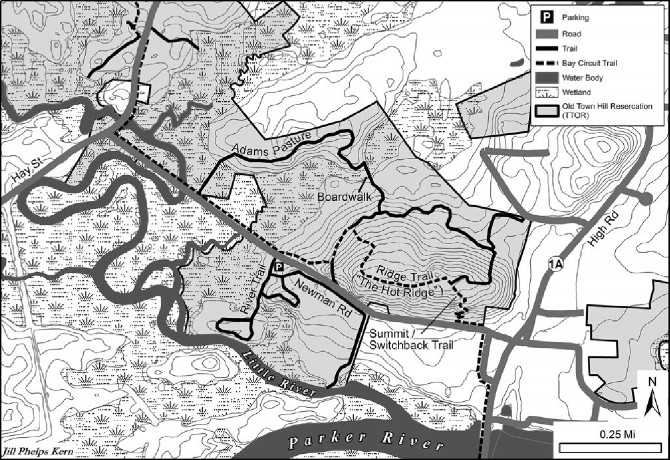
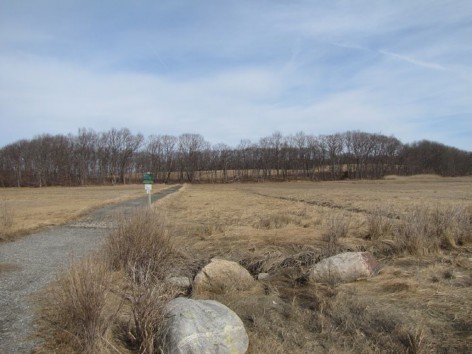
View of Adams Pasture and salt marsh from Newman Road. Photographs, unless otherwise indicated, by Peter Oehlkers.
Directions, Parking, and Fees
There are multiple trailheads on the property. Most of them are accessed by parking on Newman Road, which extends from Route 1A in Newbury to Hay Street in Newbury. A large parking area at the bottom of the Old Town Hill area on Newman Road is the main parking area, but there are smaller pulloffs at each of the trailheads that can accommodate one or two cars.
The Trustees website gives these directions to the property: From Interstate 95 Exit 54, take Route 133 East for 4.5 miles. Turn left onto Route 1A North and follow for 4.8 miles. Shortly after passing over the Parker River, turn left onto Newman Road and follow for 0.5 mile to parking (10 cars) on left. Look for trailheads along Newman Road. There is no charge to use the property.
The Trails
This trail map of the Old Town Hill properties is similar to the Trustees of Reservations’ map, except that it includes my unofficial names for the trails that I describe. In this map, the shaded areas are the Old Town Hill properties. Trails are marked with dark lines. The two roads that pass through the property are Newman Road, running east-west, and Hay Street at the left of the map, running north-south.
The trails will be described in order from their intersection with these two roads, beginning at the east on Newman Road and working west.
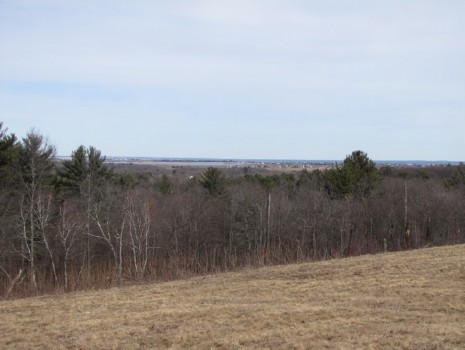
View from the summit of Old Town Hill.
The Summit Trail and The Hot Ridge. The most popular trail begins at a barrier on Newman Road 100 feet or so west of its intersection with Route 1A. The trail proceeds up Old Town Hill with a few switchbacks and opens out at the summit. Spring birding is good in this area. Indigo Buntings and Rose-breasted Grosbeaks are found at the base of the trail, and at the summit Scarlet Tanagers, Pine Warblers, and Indigo Buntings are reliable nesters. Twice I have seen male buntings and tanagers in the single tree on the summit—a memorable sight. Eighteen years ago one could hear Ruffed Grouse booming from the summit in early spring, but not to my knowledge since then. Olive-sided Flycatchers have been observed at the top of the hill, as well as a variety of warblers in May. The summit is the point on the property with the best views.
If the hiker is in a hurry, returning by the switchback trail provides a quick retreat, but continuing west on the Ridge Trail takes the hiker along a ridge between a field on the right and a wooded area on the left. My birding friends and I call this area “The Hot Ridge” because in spring it is the first area to warm up in the morning, and when there are warblers in the area, they will be here. Old Town Hill attracts thrushes in spring, and this trail is a good place to find them. After turning to the right, the trail proceeds down a hill and turns left, to return to Newman Road.
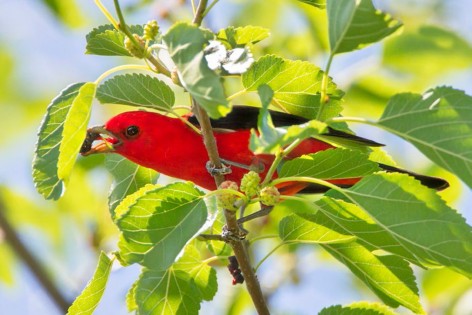
Scarlet Tanagers are reliable nesters at the summit of Old Town Hill. Photograph by Sandy Selesky.
The Boardwalk and Adams Pasture Trail. There is a trail to the north at the base of the hill below The Hot Ridge. If the hiker takes this trail and bears left in 150 feet or so, the trail proceeds to a boardwalk across a tributary to the marsh. There are good views up and down the marsh from the boardwalk. On the other side of the boardwalk the trail continues through woodlands and meets a more-traveled trail. Bearing left on that trail takes the hiker to Adams Pasture and then along its south edge. Adams Pasture is a field noted for its Bobolinks arriving in spring and nesting in the summer. Near the far side of Adams Pasture the trail veers left to pass through trees and then a section of salt marsh, arriving on Newman Road. This salt-marsh area is reliable during nesting season for Saltmarsh Sparrow and Marsh Wren. In spring, one can often hear Virginia Rails calling in the spartina. This trail is one of my favorites in the area, passing through hilltop views, deciduous and pine forest, pastures, and salt-marsh terrain. Warbler fallouts are possible here in May, and hundreds of robins roost in the wooded area in the winter. Note: I recommend that the hiker walking this trail for the first time proceed in the direction from Old Town Hill to Adams Pasture, as described, since the trail can be difficult to locate when passing in the reverse direction.
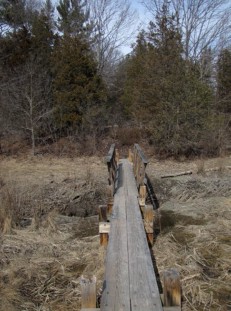
Boardwalk Trail.
The Hill Trail. At the top of the Newman Road hill, there are a pulloff and two trailheads. The trail south of the road passes through a field where Bobolinks nest in the summer and continues to the Little River. The trail north of the road is one terminus of the trail from the top of Old Town Hill to Newman Road, described above.
The Lower River Trail. Another trail to the Little River begins at the main parking lot at the base of the hill on Newman Road. It passes through woodlands, follows the bank of the Little River, and returns along the edge of the salt marsh.
The Salt Marsh Trail. At the point where Newman Road crosses the Little River, there is a pulloff and a trail passing north from Newman Road through the salt marsh, through the trees, and along the south side of Adams Pasture. This is the other end of the Adams Pasture trail described above.
The Hay Street Trails. Two short trails, one on each side of the road, lead from a pulloff on Hay Street about one quarter mile north of its intersection with Newman Road. This area is also part of the Old Town Hill property. Each of these trails begins at a green gate and each leads to freshwater wetlands and marsh. The trail on the west is part of the Bay Circuit Trail, which emerges from the woods at the parking pulloff.
Driving Newman Road
Although the trails provide looks at many birds that cannot be seen from the car, local birders often drive Newman Road on their way to or from Plum Island or other destinations and stop to examine the marsh. A series of pools at the bottom of the Newman Road hill often contains shorebirds and ducks, and this is a favorite spot during summer months for Glossy Ibis. On summer evenings, Whip-poor-wills can be heard from Newman Road. Horned Larks often feed in the frozen marsh in winter. A variety of rarities have been observed in this area. Sandhill Cranes have spent time here. Northern Shrikes have been observed in the trees bordering the marsh, and Rough-legged Hawks are unusual but regular visitors to the area. A bonus for the birder stopping on Newman Road along the marsh is the view of the oxbows in the Little River as it meanders through the salt marsh on its way to join the Parker River.
Nearby Birding Areas
In addition to the areas on the Old Town Hill reservation, there are several spots nearby that are worth checking in season.
Just south of Newman Road on Route 1A is the Parker River Bridge, where the river sometimes freezes down to a single opening in winter. Three merganser species, as well as a variety of river ducks and loons, can be concentrated near the bridge. In warmer times, the waterfowl are distributed up and down the river but can be observed from the sidewalk on the bridge. The parking lot at the bridge requires a boating permit, but one can park off the highway or in the Old Town green and walk the short distance to the bridge.
Quill Pond (also known as Icehouse Pond) on Hay Street is worth checking, especially now that domestic Mute Swans are no longer allowed to spend their days on the pond, chasing away native waterfowl. If you are proceeding up Hay Street, Orchard Orioles have nested for the last 18 years or so near the intersection of Hay Street and Low Street. Owling can also be good on Hay Street. Last year, Great Horned, Barred, and Screech owls were heard from the road, calling at night.
Precautions
Do remember that mosquitoes breed in the salt marshes in the summer, and greenhead flies can be numerous in July and August, so bring insect repellent if you are walking on the reservation in the summer months. And if you walk through grassy areas in the warmer months, be sure to take precautions and check for ticks afterward.
Conclusion
If you are looking for a scenic and birdy area to visit in the Parker River region of Essex County, Old Town Hill’s short trails and longer loops can provide you with interesting birds in any season. The Old Town Hill reservation is a little-known gem that is worth visiting on the way to or from Plum Island or, as local birders know, for its own sake.
References
- Coffin, Joshua. 1977. A Sketch of the History of Newbury, Newburyport and West Newbury. Hampton, New Hampshire: Peter E. Randall, Publisher. See p. 368 for the full, rolling, oratorical sentence in which the sheep look down on the marshes from Old Town Hill.
- The Trustees of Reservations. 2007. Old Town Hill Management Plan. Accessed online. Contains a detailed history of the property and the Trustees’ recommendations for preserving and maintaining it.
David Davis is the current Poet In Residence at Mass Audubon’s Joppa Flats Education Center in Newburyport. He has lived in Newbury for nineteen years and birds the Old Town Hill area at least weekly, walking to the property from his house along Hay Street and Newman Road. He began birding in Colorado in the 1960s. Davis is an artificial intelligence consultant and high- tech entrepreneur who uses genetic algorithms—evolution simulated on a computer—to solve difficult real-world problems.